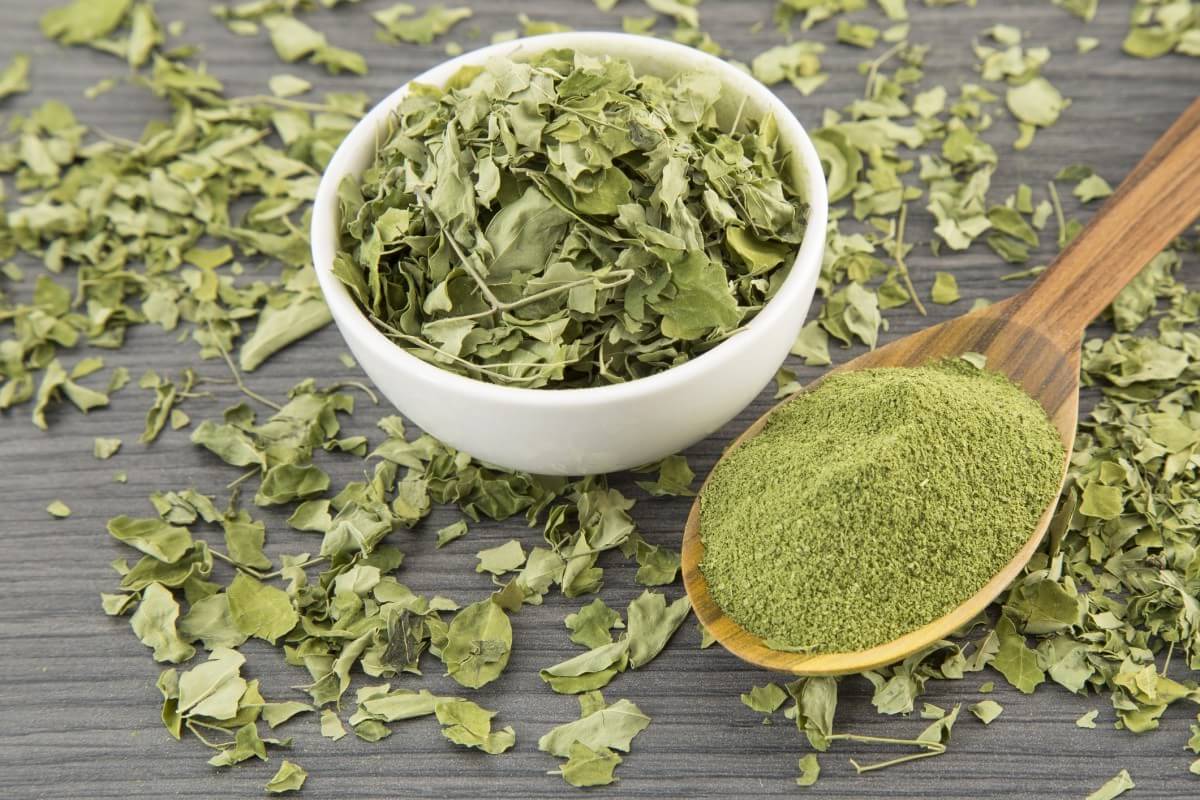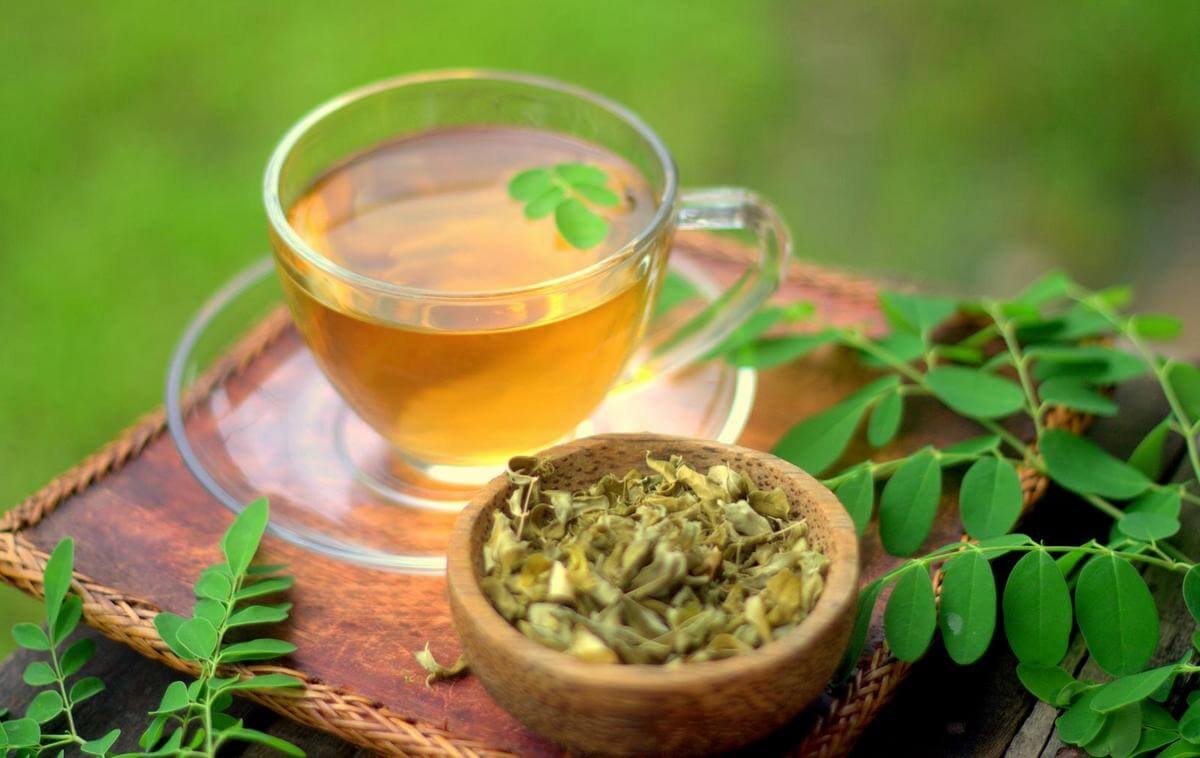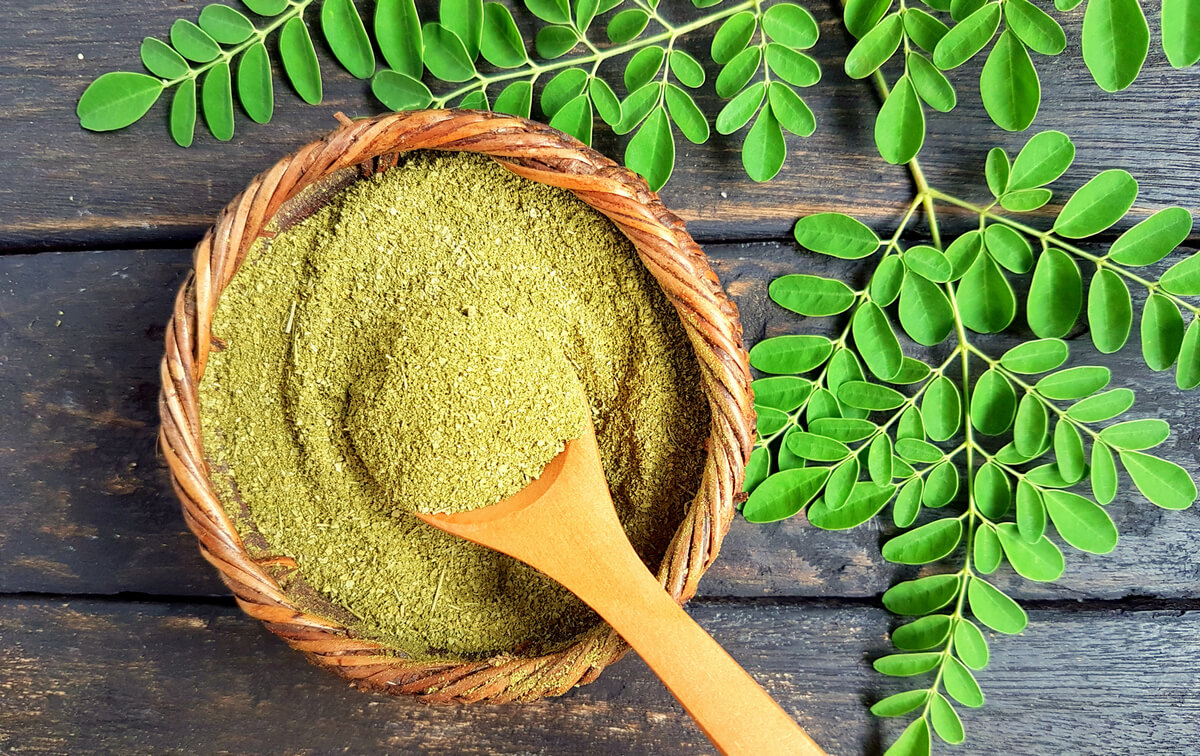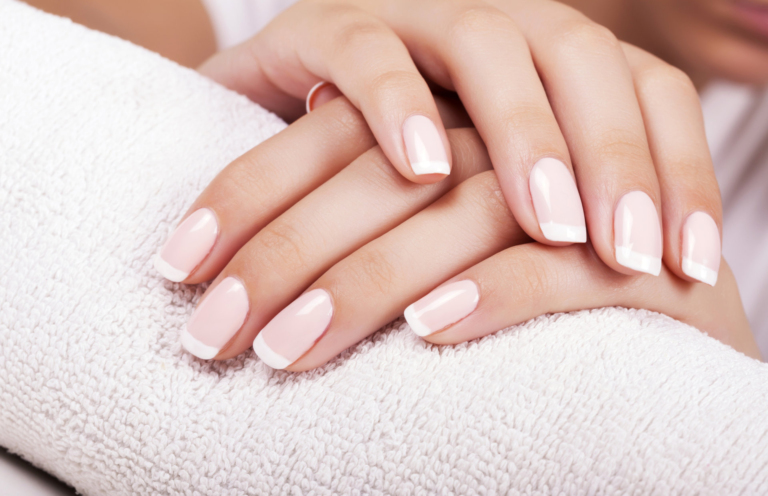What is moringa?
The following article does not constitute medical advice and is not a substitute for medical consultation.
Consult your doctor or pharmacist before using Moringa.
Moringa is a “miracle tree” that grew in the Himalayan foothills thousands of years ago.
In traditional Ayurvedic medicine, it was used to treat a wide range of ailments.
And this was absolutely true, for today it has been confirmed that all parts of the tree contain many valuable health-promoting substances.
The plant’s roots, leaves, bark, fruit and flowers contain unsaturated fatty acids, antioxidants, amino acids and large quantities of vitamins and minerals.
The seeds of the moringa fruit are used to produce oil, which is used not only in cooking, but above all in cosmetics for skin and hair care.
Find out what moringa contains and how it affects health and beauty.
Moringa is also known as the horseradish tree (the name comes from the particular taste of its roots), a tropical plant that has been growing for thousands of years in what are now India and Pakistan.
Today, it is found in the warm climates of Asia, South America and Africa.
The tree reaches a height of 5 to 10 metres, and its leaves resemble those of an acacia: they are small, slightly oval and grow in clusters.
During the flowering season, the moringa is covered with small, cream-colored flowers.
According to doctors of the time, it was used to combat epilepsy, dysentery, asthma and dizziness.
Our ancestors also discovered the use of moringa in cooking and cosmetics.
In addition, they used the bark of the moringa plant to make paper and rope, and the seeds were used to purify water due to their antibacterial properties.
In Nigeria, moringa leaves are used as a cleaning agent.
The great advantage of the “miracle tree” is that all its parts contain healing substances.
Roots, bark, leaves, flowers, shoots and fruit contain omega-3, omega-6 and omega-9 unsaturated fatty acids, vitamins A and C, minerals such as iron, calcium, potassium, manganese, chromium and boron, as well as antioxidants and zeatin (a substance that enables our bodies to better absorb vitamins and minerals).

Vitamin A improves skin condition
Moringa is a veritable treasure trove of vitamins A and C, making it excellent for our health.
Regular consumption of the plant’s leaves boosts immunity, fights inflammation in the body and helps cope with infections.
The plant acts as a natural antibiotic, with antibacterial and antifungal properties.
Vitamin A improves skin condition and is responsible for good vision.
Unsaturated fatty acids reduce bad cholesterol levels and strengthen blood vessel walls, protecting against atherosclerosis and other heart diseases.
In turn, large quantities of various antioxidants eliminate free radicals from the body and prevent premature cell aging.
Also read: moringa oil – benefits for hair
Significantly, there’s 4 times more vitamin A in Tree of Life than in carrots, 7 times more vitamin C than in oranges, and 25 times more iron than in spinach.
Sounds incredible, but it’s an all-natural product that can strengthen your body’s work.
As well as vitamins, it also contains minerals such as calcium, magnesium, copper, manganese, boron, chromium, iron, zinc, potassium and phosphorus.
What’s more, moringa contains 46 antioxidants (the most important of which are salvesterol, chlorophyll and zeatin), making it ideal for helping to neutralize free radicals.
Salvesterol is a substance that may be useful in supporting therapy for certain diseases of civilization, as scientists have discovered that it can aid and support therapy to combat cancerous tumors.
Chlorophyll is useful for cleansing the body, while zeatin is responsible for the absorption of vitamins, trace elements and amino acids.
Tree of life has antibacterial and antiviral effects.
They also reduce the risk of cancer and diabetes.
Moringa is also high in iron, which protects against anemia, and potassium, which lowers blood pressure.
Calcium and manganese help keep bones and joints in good condition.
Chromium (accelerates metabolism and helps combat stress) and boron (stimulates brain function) are also extremely valuable.
The leaves and seeds, as well as the plant’s pods, can be used successfully in cooking.
The leaves taste a little like watercress and can be added to vegetable salads or sandwiches.
They can also be substituted for spinach.
Moringa leaves are also available dried and ground, and make a healthy addition to yogurts, smoothies, soups and sauces.
They can be taken three times a day, at 1.5 grams each, preferably with food.
The dried leaves can also be used to make tea, and moringa pods have a taste similar to that of asparagus.
The oil produced from moringa seeds is also good for the health: it is mainly composed of oleic acid, which reduces cholesterol levels and protects against atherosclerosis.
The plant should not be consumed by pregnant women, as it increases the risk of miscarriage.
In cosmetics
Moringa seed oil is also interesting for external use on skin and hair.
It has strong moisturizing and nourishing properties, making hair smooth and manageable.
The oil is also useful for a relaxing massage.
What are the medicinal properties of moringa leaves?
In the ranking of healthy, unprocessed foods known as “superfoods”, moringa leaves occupy one of the top spots.
The moringa oleifera tree is a treasure trove of life-giving nutrients and antioxidants.
What is moringa, what medicinal properties does it have and how does it support the human body?
Moringa leaves: what are they?
What is moringa and what does it look like?
This exotic plant resembles the Robinia, with elongated, woody branches several meters long.
What does a moringa leaf look like?
It’s deep green, oval-shaped and forms a symmetrical arrangement with the other leaves, which grow uniformly from slender twigs.
The root, fruit, seeds and leaf of the moringa plant were used for medicinal purposes hundreds of years ago in the Middle East, South Asia, America and North Africa.
Moringa herbs are made from the leaves, which undergo a careful selection and drying process, before being cut or ground.
How are moringa leaves used today?
They are used in a wide range of applications, such as health teas and medicinal infusions.
The tree’s seeds produce nutritious oils for external use.
From the bark, roots and fruit, herbalists extract a regenerating moringa extract that is used, among other things, in the production of tablets and capsules.
Moringa properties and healing effects
Moringa herbs have been used in natural medicine for thousands of years.
The curative properties of this exotic tree are varied.
Moringa has many beneficial effects:
- Anti-inflammatory and antioxidant
- Bactericide
- Antipyretic
- Diastolic
- Diuretic
Moringa leaf extract can be used by people suffering from stomach ulcers, hypertension and diabetes after consulting a doctor.
The plant helps regulate blood sugar levels, strengthens the immune system and the upper respiratory tract, and inhibits inflammation of the throat, bronchi and lungs.
It is a natural ally in the fight against recurrent respiratory infections.

Moringa leaves: properties and nutrients
What does moringa leaf contain?
The properties of the dried product and the extract are still the subject of intensive scientific research, but we already know that moringa contains..:
- Vitamins: A, B1, B2, C, E, K
- Minerals: calcium, potassium, iron, zinc, copper, chromium
- Highly digestible dietary fiber
- Amino acids
- Unsaturated fatty acids
- Omega-3 and omega-6 fatty acids
- Antioxidants and flavonoids
What is moringa used for, and why drink moringa leaf infusion regularly?
The action of green leaves is versatile: they oppose the proliferation of free radicals, inhibit oxidation and cellular aging processes, and eliminate toxins and bacteria.
Moringa leaf has calming and anti-stress properties, making it a natural remedy for fatigue, low morale and poor concentration.
Moringa leaves: how to use them?
The antioxidant properties of moringa have been appreciated since ancient times.
Thousands of years ago, the first recipes and treatment methods were developed for the precious moringa leaves.
The plant’s uses are impressive:
- Dried powder can be drunk with boiled water
- Broken leaves are perfect for infusions
- Moringa leaf extract is a dietary supplement and natural cosmetic
- Moringa powder, with its slightly bitter taste, is a spice that perfectly complements and enriches the flavour of various dishes.
How to drink moringa tea
A very popular product made from Moringa oleifera leaves is moringa tea.
Reviews of dried moringa infusions are very positive.
People who use this natural plant frequently are less likely to suffer from infections and other health problems.
Simply drink moringa tea once or twice a day.
Moringa tea: how to brew dry tea?
Moringa for drinking is perfect!
How to brew moringa tea
Pour hot water over the dried moringa leaves, no more than half a teaspoon into the tea. The optimum water temperature is 95°C, and never pour boiling water at 100°C over the herb.
It’s best to cover the container with a ceramic lid and wait at least 5 minutes for the dried herb to release its beneficial substances.
How does moringa tea affect the body?
Regular consumption of moringa triggers a number of positive changes in the body, which can be seen and felt both inside and outside the body.
Is it worth drinking moringa tea?
The effect of the infusion is complex: the plant stimulates the work of all the organs – stomach, intestine, heart, brain and liver.
Moringa has a beneficial effect on skin condition, reduces inflammation and eczema, and strengthens eyesight.
Moringa seeds and oil: properties
How are moringa seeds used and what are their benefits?
Moringa seeds are used to produce an oil that deeply strengthens skin, hair and nails.
This natural product is for external use only, for frictions and massages.
Rub it into the skin 1-2 times a day to rebuild and strengthen cells.
Moringa seed oil has a disinfectant and moisturizing effect.
Moringa powder and tablets: properties
Moringa powder is very popular in natural medicine and dietetics.
It has a wide range of uses, from drinks to seasonings for salads, dips, sauces and vegetable smoothies.
Like the chopped moringa leaf, the powder has antioxidant, regenerative and antibacterial properties.
Capsules and tablets containing 100% moringa extract are another well-known and popular product made from moringa leaves, fruit and roots.
Moringa oil-based organic tablets have antiviral and antibacterial properties, regulating blood pressure and the digestive, nervous, endocrine and immune systems.
Moringa, also known as the tree of life, horseradish tree or longevity tree, is a species of tropical tree belonging to the moringa family.

Using Moringa
Most people are interested in the tree of life because of its sensational medicinal properties.
This product fits in well with the diet of people struggling with low immunity.
It’s a well-known fact that more and more people today have to contend with colds and flu.
The reason for this is, of course, our low immunity, which manifests itself especially at the turn of autumn and winter.
If you also belong to this group of people, it’s certainly worth including horseradish in your diet.
It supports the fight against infection (thanks to its antioxidant content) and provides a high dose of vitamins and minerals.
Another group of people who should definitely be interested in this product are those struggling with concentration problems and notorious fatigue.
Fatigue is most often the result of mineral and vitamin deficiencies.
Consequently, the use of this plant will affect both our productivity and energy, and reduce symptoms of exhaustion after a long day.
An important property of moringa, especially for women, may be the fact that it aids the weight loss process.
If you want to lose a few extra kilos, make moringa leaves part of your diet.
It improves the utilization of energy from food, allowing less energy to be stored in the form of adipose tissue.
Tree of life is also very likely to help combat oxidative stress.
If you’re struggling to soothe your nerves after a long day, and don’t know how to calm down, this plant will probably be the right choice for you.
Thanks to its high antioxidant content, you’ll be able to reduce the effects of stress.
Another advantage of using the tree of life is that it improves and supports intestinal peristalsis.
The use of moringa leaves is recommended to all those who struggle with constipation, thanks to them, the work of the digestive tract will be improved and supported.
Some theories claim that moringa can be used to protect against gastrointestinal and urinary tract infections.
In addition, the moringa plant is distinguished by the fact that it supports blood sugar regulation processes.
If you want to support diabetes prevention, consume moringa and exercise regularly, the likelihood will certainly decrease.
People who habitually smoke or abuse alcohol should also be pleased with the use of the tree of longevity.
The plant takes care of replenishing all necessary vitamins and also supports liver function.
It’s also interesting to note that moringa is increasingly used by people who want to build muscle mass.
The reason for this positive effect lies in the amino acids present in this plant.
Moringa is good for the elderly, as it supports brain function and influences the nervous system.
As such, it can help prevent age-related illnesses such as Alzheimer’s disease.
In addition to its use in natural medicine, the plant is also ideal for cosmetics.
Most people use it to strengthen their hair and skin.
Also read: turmeric for hair
Oil is best for this purpose, as it moisturizes, smoothes and nourishes.
It’s also good to know that more and more manufacturers are adding moringa to their preparations, mainly lotions, emulsions and creams.
The young shoots, fruits and leaves of moringa are used in cooking.
They can be added to salads, smoothies, yoghurts and soups.
Various infusions and oils are easily prepared from the tree of life.
Most people probably don’t know that the tree of life is used to produce biofuels, as well as to purify polluted water.
Some people like to add moringa to animal feed and use it as a blue stain for wood.

Dosage
Moringa can be used in a number of ways, depending on the product you have available.
One of the most popular products is moringa oil, which has a high oleic acid content and is ideal for people with dry, sensitive skin.
It has a moisturizing, nourishing and soothing effect.
It is also good for hair regeneration.
Dried, chopped or ground leaves are also commercially available.
Both products can be prepared as an infusion, with a recommended daily dose of no more than 4 grams.
It’s important not to exceed the dose, as this can be associated with unpleasant side effects.
When we buy powdered leaves, we can add them to many dishes prepared in our kitchen.
Most people add them to salads, yoghurts or smoothies.
For powdered leaves, consume no more than one teaspoon a day. The amount of moringa we consume should depend on our problems.
Unless your doctor advises otherwise, you can start with half a teaspoon for a few days, then use a teaspoon a day, or even twice a week.
Using moringa can have side effects, so it’s a good idea to consult your doctor.
It is a product with powerful effects and properties.
Contraindications include pregnancy, as moringa flowers, roots and bark can cause uterine contractions and miscarriage.
“One of my biggest dreams is that my company will be able to change the course of one family’s life, one child at a time by giving back to the community.”







